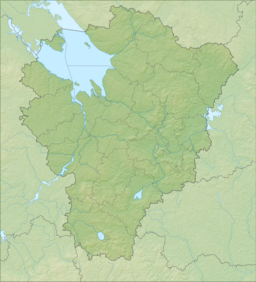geo.wikisort.org - Reservoir
Rybinsk Reservoir (Russian: Ры́бинское водохрани́лище, tr. Rybinskoye vodokhranilishche, IPA: [ˈrɨbʲɪnskəɪ vədəxrɐˈnʲilʲɪɕə]), informally called the Rybinsk Sea, is a water reservoir on the Volga River and its tributaries Sheksna and Mologa, formed by Rybinsk Hydroelectric Station dam, located in the Tver, Vologda, and Yaroslavl Oblasts. At the time of its construction, it was the largest man-made body of water on Earth.[1] It is the northernmost point of the Volga. The Volga-Baltic Waterway starts from there. The principal ports are Cherepovets in Vologda Oblast and Vesyegonsk in Tver Oblast.
| Rybinsk Reservoir | |
|---|---|
 The lake in winter | |
| Coordinates | 58°22′N 38°26′E |
| Type | Hydroelectric reservoir |
| Primary inflows | Volga, Sheksna, Mologa |
| Basin countries | Russia |
| Surface area | 4,580 km2 (1,770 sq mi) |
| Average depth | 5.6 m (18 ft) |
| Max. depth | 28 m (92 ft) |
| Water volume | 25.4 km3 (6.1 cu mi) |
| Surface elevation | 102.4 m (336 ft) |
| Settlements | Cherepovets Vesyegonsk |

The construction of the dam in Rybinsk started in 1935. The filling of the reservoir started on April 14, 1941, and continued until 1947. Some 150,000 people had to be resettled elsewhere, and the historic town of Mologa in Yaroslavl Oblast along with 663 villages have completely disappeared under water. Today the dam is less important for hydroelectric power supply (output is 346 MW) than it used to be.
References
- Paul R. Josephson. Industrialized Nature: Brute Force Technology and the Transformation of the Natural World. Island Press, 2002. ISBN 1-55963-777-3. Page 31.
External links
- Detailed map of the reservoir (in Russian)
- Webpage of the Leushino Monastery, now submerged under the waters of the Rybinsk Sea (in Russian)
| Wikimedia Commons has media related to Rybinsk Reservoir. |
На других языках
[de] Rybinsker Stausee
Der Rybinsker Stausee (russisch Рыбинское водохранилище/ Rybinskoje wodochranilischtsche), der aufgrund seiner enormen Größe (Fläche 4580 km²; Stauvolumen 25,4 Mrd. m³) auch Rybinsker Meer genannt wird, ist ein Stausee an der Wolga in Russland.[1][2] Er ist Teil der sogenannten Wolga-Kama-Kaskade und der nach dem Kuibyschewer Stausee zweitgrößte Stausee in Europa.- [en] Rybinsk Reservoir
[es] Embalse de Ríbinsk
El embalse de Ríbinsk (en ruso, Ры́бинское водохрани́лище, romanizado: Rýbinskoye vodojranílische), informalmente llamado el mar de Ríbinsk, es un vasto embalse artificial localizado en el curso superior del río Volga. El gran embalse comprende parte de los óblasts de Tver, Vólogda y Yaroslavl. El embalse, que alimenta la estación hidroeléctrica de Ríbinsk, incluye varios elementos de contención: una presa de hormigón con aliviadero y un dique de tierra de 524 m de largo y 27 m de altura en el curso del Volga; una presa de tierra en el río Sheksná, de 470 m de largo y 35 m de altura; y diques de canalización en el mismo río Sheksná de una longitud de 6035 m. En el embalse también desagua el río Mologa (456 km).[fr] Réservoir de Rybinsk
Le réservoir de Rybinsk ou réservoir Rybinskoïe (en russe : Рыбинское водохранилище, Rybinskoïe vodokhranilichtche), parfois appelé mer de Rybinsk, est un vaste réservoir d’eau douce situé sur le fleuve Volga à 380 km au nord de Moscou, en Russie. Il a été entièrement réalisé par les détenus de ce que Soljenitsyne nommait « l'hydrogoulag ».[ru] Рыбинское водохранилище
Ры́бинское водохрани́лище (разг. Ры́бинское мо́ре) — большое водохранилище на реке Волге и её притоках Шексне и Мологе. Расположено на севере Центральной России — в основном в Ярославской области (3246 км²[источник не указан 694 дня]), частично также в Тверской и Вологодской областях. Объём воды: полная ёмкость — 25,4 км³[4][5]; полезная ёмкость — 16,7 км³[6]. Площадь поверхности — 4580 км²[4][5]. Высота над уровнем моря — 101,81 м[7].Другой контент может иметь иную лицензию. Перед использованием материалов сайта WikiSort.org внимательно изучите правила лицензирования конкретных элементов наполнения сайта.
WikiSort.org - проект по пересортировке и дополнению контента Википедии







